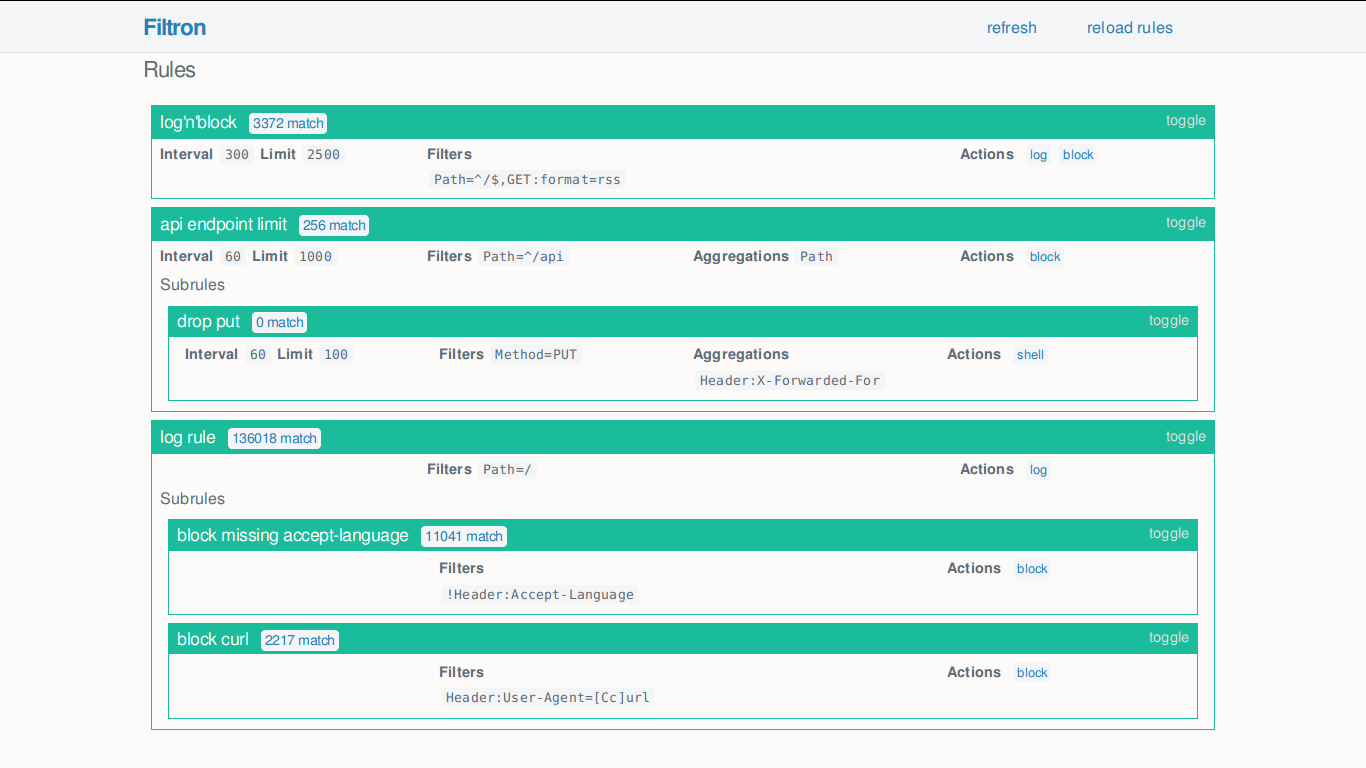Reverse HTTP proxy to filter requests by different rules. Can be used between production webserver and the application server to prevent abuse of the application backend.
The original purpose of this program was to defend SearXNG, but it can be used to guard any web application.
$ go install github.com/searxng/filtron@latest
$ "$GOPATH/bin/filtron" --help
A rule has two required attributes: name and actions
A rule can contain all of the following attributes:
limitinteger - Defines how many matching requests allowed to access the application withinintervalseconds. (Can be omitted if0)intervalinteger - Time range in seconds to reset rule numbers (Can be omitted iflimitis0)filterslist of selectorsaggregationslist of selectors (iffiltersspecified it activates only in case of the filter matches)subruleslist of rules (iffiltersspecified it activates only in case of the filter matches)disabledbool - Disable a rule (default isfalse)stopbool - Finish request validation immediately and skip remaining rules (default isfalse)
JSON representation of a rule:
{
"name": "example rule",
"interval": 60,
"limit": 10,
"filters": ["GET:q", "Header:User-Agent=^curl"],
"actions": [
{"name": "log",
"params": {"destination": "stderr"}},
{"name": "block",
"params": {"message": "Not allowed"}}
]
}Explanation: Allow only 10 requests a minute where q represented as GET
parameter and the user agent header starts with curl. Request is logged to
STDERR and blocked with a custom error message if limit is exceeded. See more
examples here.
Rule's actions are sequentially activated if a request exceeds rule's limit
Note: Only the rule's first action will be executed that serves custom response
Log the request
Serve HTTP 429 response instead of passing the request to the application
Execute a shell command. cmd (string) and args (list of selectors) are
required params (Example: {"name": "shell", "params": {"cmd": "echo %v is the IP", "args": ["IP"]}})
If all the selectors found, it increments a counter. Rule blocks the request if
counter reaches limit
Counts the values returned by selectors. Rule blocks the request if any value's
number reaches limit
Each rule can contain any number of subrules. Activates on parent rule's filter match.
Request's different parts can be extracted using selector expressions.
Selectors are strings that can match any attribute of a HTTP request with the following syntax:
[!]RequestAttribute[:SubAttribute][=Expression]
!can negate the selectorRequestAttribute(required) selects specific part of a request - possible values:- Single value
IPHostPathMethod
- Multiple values
GETPOSTParam- it is an alias for bothGETandPOSTCookieHeader
- Single value
SubAttributeifRequestAttributeis not a single value, this can specify the inner attributeExpressionpossible value:- a regular expression to filter the selected attribute values.
nslookup(Hostname)to filter the selected attribute values with the IP addresses ofHostname. Filtron resolvesHostnameto its IP addresses when the rule is loaded (IPv4 and IPv6).
IP returns the client's IP address
GET:x returns the x GET parameter if exists
!Header:Accept-Language returns true if there is no Accept-Language HTTP header
Path=^/(x|y)$ matches if the path is /x or /y
IP=nslookup(example.com) matches if the client's IP address is one of the IP
addresses of example.com.
Filtron can be configured through its REST API which listens on 127.0.0.1:4005
by default.
Loaded rules in JSON format
Reload the rule file specified at startup
UI built on the API
Bugs or suggestions? Visit the issue tracker.
